| IGNEOUS ORIGIN: OBSERVED AND INFERRED
|
| ALTERNATIVE HYPOTHESES |
 | A major argument for an igneous origin for cross-cutting rock body 'A' (see the diagram to the left) is the presence of folds in the adjacent rock layers. Folding is a form of plastic deformation and favored by a high temperature environment, such as that associated with the intrusion of molten rock (magma).  Furthermore, the crystalline character of rock 'A' and the increase in grain size from its marginal to central parts (indicative of faster cooling at the edges and slower cooling in the interior) support origin through cooling and crystallization of a melt.  The altered texture and mineralogy of the sedimentary layers adjacent to the intrusive  can be attributed to elevated temperatures imposed by the melt. can be attributed to elevated temperatures imposed by the melt. |
But an alternative hypothesis might be that rock body 'A' originated through precipitation of minerals from a hot watery solution, such as heated groundwater, rather than through crystallization from a cooling rock melt. In theory, water injected under high pressure could exert lateral pressure to cause folding and slaty cleavage. Heat from the solution could allow the adjacent rocks to behave plastically. Chemical reactions between the solution and the surrounding rocks could produce the altered zones.
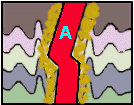 | 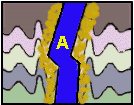 |
| MELT | SOLUTION |
|
| WORKING FROM THE KNOWN TO THE UNKNOWN |
| How can the former presence of a melt be distinguished from that of a hot solution? The igneous origin of some rocks is indisputable: those seen to form from the solidification of erupted lava. It is judged 'indisputable' because it can be seen to happen. Can a connection be made between these rocks and others whose origin can not be observed? Examine the following diagrams and narrative to see if they supply an answer to that question. | 
USGS Photo. |
|
|
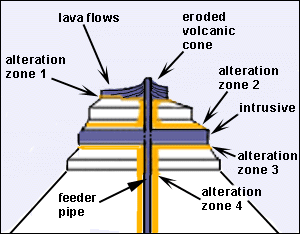

 
|
Consider the hill shown in cross section in the diagram on the left (repeated four times for ease of viewing). Remember, the geologist-observer can only see the rocks that are exposed at the surface. (Note light blue sky.)
Observation: Upon close examination, the uppermost rocks (dark blue) form a cone composed of layers sloping down and away from its apex. Each layer is made of vesicular glass at its top, non-vesicular glass at its bottom, and fine-grained crystalline rock made of pyroxene, olivine and calcium-rich feldspar in its center.
Hypothesis: The top part of the hill is the eroded stump of an old volcano. The layers of which it is composed are lava flows.
Observation:
The volcanic rocks rest on a series of horizontal layers. All of the horizontal layers, except the one colored dark blue, contain fossils, mudcracks, etc. The topmost layer, where it is in contact with the overlying lava flows, shows signs of alteration (zone 1).
Hypothesis: The horizontal layers are sedimentary rock. The alteration of the top of the topmost layer was due to the heat from the lava flows when they flowed out over the layer.
Observation: The dark blue horizontal layer is crystalline and made of the same minerals (olivine, pyroxene and calcium-rich feldspar) as the lava flows. The upper and lower parts of the layer have grains that are finer than those in the middle. Distinct narrow zones (2 and 3) of rock of unique character occur under the bottommost lava flows and above and below the dark blue layer. The characteristics of the adjacent sedimentary rocks can be seen in these zones but in an altered state.Hypotheses: The dark blue layer is an igneous intrusive formed by molten rock similar to that which erupted as lava. The 'zones of unique character' are metamorphic, produced by the baking of the sedimentary rocks in contact with molten rock. 'Alteration Zones' seems an appropriate term for them. Hypothesis: The geologist cannot see the feeder pipe and associated alteration zones (4), but assumes it must be there as there had to be a conduit to convey molten rock to the surface. That same conduit may have also fed molten rock to the horizontal intrusive. |
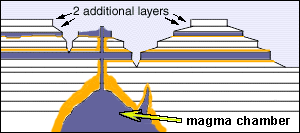 
| The geologist then conducts a broader survey. Observation: The hill described above sits between two other hills. The sequence of rocks of which these hills are composed is the same as those that make up the first hill, except that two additional sedimentary layers sit on top of the lava flows layer.
Hypothesis: All three hills were once joined but have been separated by erosion.
Hypothesis: At some depth beneath the surface, there must be a magma chamber. It has probably cooled and solidified since there has been no volcanic activity for a long time. The length of time since volcanic activity ceased is judged to be long because a long time is probably required to erode the material that once joined the hills together. |
 
|
The geologist then extends the survey to a neighboring region. Observation: The area is underlain by horizontal sedimentary rock layers. Over a large area, the sedimentary rocks have been invaded by a great irregular mass of coarsely crystalline rock whose mineralogy (olivine, pyroxene and calcium-rich feldspar) is similar to that of the previously described lava flow and dark blue horizontal intrusive rock. A similar rock mass of smaller size occurs nearby. Both rock masses are surrounded by alteration zones.
Hypothesis: These rock masses are part of a huge solidified magma chamber that, when it was molten, fed the lava flow and the horizontal intrusive rock body described above. These bodies are visible because in this region, more material has been removed by erosion. |
| SUMMARY OF THE SEQUENCE OF EVENTS ENVISIONED BY THE GEOLOGIST. OBSERVATIONS AND HYPOTHESES ARE WELDED TOGETHER INTO A NARRATIVE. |
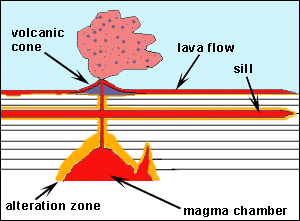 | Stage 1: From an erupting volcano lava flows spread out as thin sheets over a landscape underlain by horizontal sedimentary rocks. The source of the erupting lava is a magma chamber which intrudes the sedimentary rocks at depth. On the way up to the surface, magma forced its way laterally between sedimentary rock layers to form a 'sill'. (A sill is an intrusive that parallels the layers it intrudes.) Zones of metamorphism are indicated in tan. |
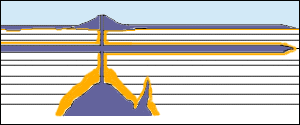 | Stage 2: The volcano has become extinct. |
 | Stage 3: Erosion reduces the volcanic cone to a stump. |
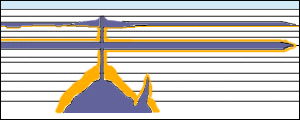 | Stage 4: The whole area is buried by layers of sediment, which turns into sedimentary rock. |
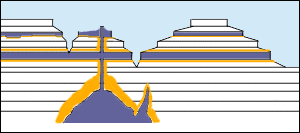 | Stage 5: Erosion dissects the landscape, revealing parts of the buried volcanic cone, lava flow and sill. |

Stage 6: Deeper erosion in a neighboring area reveals the solidified magma chamber that underlies the whole region. |
| THE MINERALOGY OF IGNEOUS ROCKS - THE GEOLOGIST'S REASONING In the preceding argument, the geologist started with rocks bodies whose origin is observed. Then, (s)he used identical or similar features found in other rock bodies to infer their origin. Follow the steps of the argument as shown in the diagram and narrative: |
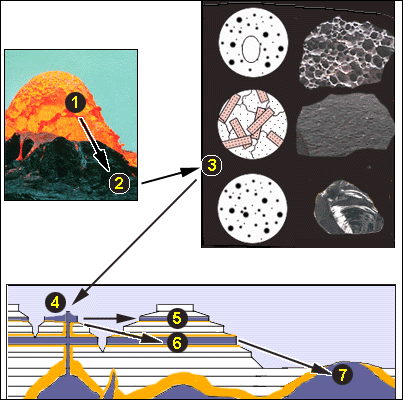 | A: Erupted molten lava (1) can be seen cooling and turning into solidified lava flows (2).
B: Each lava flow (3) has a vesicular top, a glassy bottom, and a central crystalline region made of olivine, pyroxene and calcium-rich feldspar.
C: Elsewhere, a layered cone (4) made of the same materials is found. Under it is an alteration zone. The cone is judged to be an extinct volcano; thus it is igneous.
D: An isolated layer (5) made of the same materials as the cone is found. There is an alteration zone under it. The layer is judged to be an eroded remnant of a volcanic flow; thus it is igneous.
E: A more coarsely crystalline layer (6) is found. It too is made of olivine, pyroxene and calcium-rich feldspar, with finer grains at its margins and coarser grains at it center, but lacks glass. There are alteration zones above and beneath it. It is judged to be an igneous intrusive (a sill) that cooled more slowly than the lava flows.
F: A great mass (7) of coarse-grained crystalline material made of olivine, pyroxene and calcium-rich feldspar is found. It cuts across the sedimentary layers and there is an alteration zone around its periphery. It is judged to be an igneous intrusive, the solidified magma chamber that gave rise to (4), (5), and (6). |
| Geologists have examined the products of volcanic eruptions all over the earth. They have found that compositions of the lavas and the minerals found in them vary, in some places producing light-colored rocks, in others intermediate- or dark-colored rocks. However, the minerals that characteristically occur together in the same rock (mineral assemblages) are very consistent. Certain minerals occur together; others do not. Typical assemblages are shown in this table:
| MINERALS FOUND TOGETHER IN SOLIDIFIED LAVA FLOWS |
| MINERALS: | quartz | potassium-
rich
feldspar | sodium-
rich
feldspar | musc-
ovite | biot-
ite | amph-
ibole | pyro-
xene | calcium-
rich
feldspar | olivine |
| LAVA 1: | X | X | X | X | X | - | - | - | - |
| LAVA 2: | X | X | X | - | X | X | - | - | - |
| LAVA 3: | - | - | - | - | - | X | X | X | - |
| LAVA 4: | - | - | - | - | - | - | X | X | X |
| LAVA 5: | - | - | - | - | - | - | - | X | X |
|
When information as to the percentages of each mineral is added to he table, data can be summed up graphically in the following diagram, which you encountered earlier:  |
 |
| Significantly, intrusive bodies that geologists, using the arguments outlined above, call igneous, are composed of the same mineral associations as volcanic bodies. Mineralogy, therefore, may be used as another line of evidence for igneous origin for an intrusive, the product of a melt crystallizing beneath the earth's surface. |
Experimental observation helps justify the use of mineralogy as supporting evidence for igneous origin. None of the mineral assemblages found in igneous bodies, both those whose origin is observed and those whose origin is inferred, can be crystallized from hot water solutions. Thus, the alternative hypothesis, that the intrusive (inferred igneous) bodies might be the result of crystallization of hot water solutions, is weakened. | |
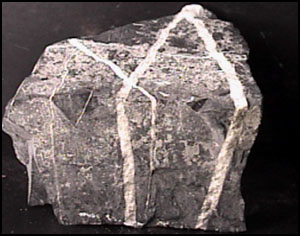 | There are intrusive, crystalline rock bodies (called "veins"  ) that are not composed of the mineral assemblages listed above. Examples include fractures filled with one hundred percent calcite or quartz. These intrusives are not considered igneous because:
The origin of these intrusives is attributed to deposition from groundwater or hot water solutions expelled from magmas. ) that are not composed of the mineral assemblages listed above. Examples include fractures filled with one hundred percent calcite or quartz. These intrusives are not considered igneous because:
The origin of these intrusives is attributed to deposition from groundwater or hot water solutions expelled from magmas. |
|
| CONCLUSIONS
Igneous rock bodies are recognized by their shapes, structures, and relationships to other rock bodies in conjunction with textural, mineralogic and experimental evidence. None of these characteristics on their own are definitive. Crystalline texture, intrusive character, zones of alteration, the presence of a particular mineral or minerals, vesicular glass, or even a cratered cone may be open to alternative explanations. But as the number of these features found together rises, the probability of igneous origin increases rapidly to the point where the geologist may point and say, with justified assurance, "this rock is igneous." Investigation then focuses on determining the precise conditions of magma formation, when and where they are likely to be achieved, details of the solidification of melts, and mechanisms of volcanic eruption.
|
 Question 1: Parts of a rock body judged to be a lava flow display a crystalline texture with needles of amphibole all lined up parallel to one another. Is such an oriented crystalline texture compatible with igneous origin? Explain. Question 1: Parts of a rock body judged to be a lava flow display a crystalline texture with needles of amphibole all lined up parallel to one another. Is such an oriented crystalline texture compatible with igneous origin? Explain.
 Question 2: A lava flow is made up of glass in which are embedded half-inch long, well-formed crystals of feldspar. How might such a texture originate? Question 2: A lava flow is made up of glass in which are embedded half-inch long, well-formed crystals of feldspar. How might such a texture originate?
 Question 3: On the face of a vertical cliff a series of off-white, horizontal sedimentary rock layers are exposed. Near the top of the series is a black layer sandwiched in between the off-white layers. Along the bottom contact with the black layer, the top part of the off-white layer is dark grey. Near the middle of the series is another black layer sandwiched in between the off-white layers. Along both its contacts with the off-white layers, the parts of the off-white layers adjacent to the black layer are dark grey. Neither the black layers nor the dark-grey zones can be examined directly, as they are too high above the ground. A geologist decides the upper black layer is a lava flow and the lower black layer is a sill. What evidence can the geologist supply to support those claims? Question 3: On the face of a vertical cliff a series of off-white, horizontal sedimentary rock layers are exposed. Near the top of the series is a black layer sandwiched in between the off-white layers. Along the bottom contact with the black layer, the top part of the off-white layer is dark grey. Near the middle of the series is another black layer sandwiched in between the off-white layers. Along both its contacts with the off-white layers, the parts of the off-white layers adjacent to the black layer are dark grey. Neither the black layers nor the dark-grey zones can be examined directly, as they are too high above the ground. A geologist decides the upper black layer is a lava flow and the lower black layer is a sill. What evidence can the geologist supply to support those claims?
|
|
To check your answers and get additional hints and information, click on the link. |